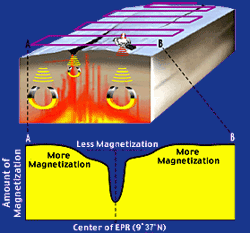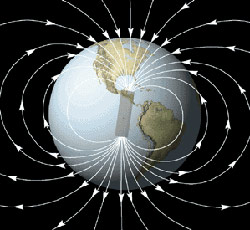|
Hot Topics: Seafloor Magnetics The Earth has a magnetic field because it is essentially a big magnet. The reason why the Earth is a magnet is because it has an inner core that is made of solid iron and nickel, two very magnetic materials, and an outer core that is more liquid. The two parts of the Earth’s core are both in motion, but they do not move in exactly the same way. Much like an electromagnet that forms when you rotate two magnetic materials around one another, the Earth’s core sets up a very strong magnetic field for planet Earth. With a magnetometer mounted on Alvin we can measure small differences in the magnetization of the rocks directly beneath Alvin. Here we show how Alvin’s magnetometer detects weakly magnetic dikes flanked by strongly magnetic lavas beneath the seafloor.  The magnetic field of the Earth. The Earth is like a big magnet with a North pole and a South pole that lie close to the geographic poles. The strength of the Earth's magnetic field changes with time, and about three times per million years it flips so that the field points completely in the opposite direction. These changes in strength and direction of the Earth's magnetic field are recorded in the volcanic rocks beneath the seafloor. The lava erupted on the seafloor is the most magnetic because it has the smallest crystals. The crystals have no time to grow any larger because the cold, near freezing seawater at the bottom of the ocean makes the lavas cool very fast. The dikes, which are the frozen conduits, or pathways that supplied the magma to the seafloor, are less magnetic because they don’t cool as fast as the lavas . The least magnetic rocks in the ocean crust are the gabbros. Gabbros are found in the lower half of the oceanic crust because they cool very slowely allowing the largest crystals to grow. With a magnetometer mounted in one of Alvin’s baskets, we can measure minute changes in the Earth’s magnetic field that are caused by changes in the magnetization of the rocks directly beneath Alvin. In this way, we can find out whether the rocks beneath the sea floor on the mid-ocean ridge crest are very magnetic or not so magnetic. For instance, if the measurements indicate that the rocks are not so magnetic, then there may be dikes hidden beneath the seafloor. If the magnetic survey lines are long enough we also get information about when the Earth’s magnetic field has flipped and how the strength of the magnetic field has changed. This has happened many times in Earth’s history for reasons that geophysicists are still trying to figure out.
|
|
© 2010 Dive and Discover™. Dive and Discover™ is a registered trademark of Woods Hole Oceanographic Institution
|
|
